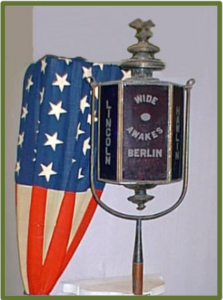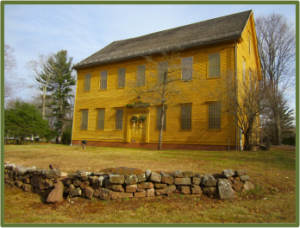Prehistoric:
- 190 million years ago – dinosaurs of late Triassic and early Jurassic periods roam the area. Anchisaurus footprints were later found while blasting for Rt. 9 in East Berlin.
- 25,000 years ago – the Ice Age covers New England.
- 15,000-18,000 years ago – receding ice creates glacial Lakes Hitchcock and Middletown, leaving behind fine silt which becomes the basis for clay.
- 10,000-13,000 years ago – Native Peoples arrive and populate the region. They call it Pagonchaumischaug – the white oak place.
European Settlement:
- 1630 the Great Migration begins-thousands of English Puritans leave their homeland to settle in the New World.
- 1633 Windsor, CT founded
- 1634 Wethersfield, CT founded
- 1636 Hartford, CT founded
- 1636 Leonard Chester of Wethersfield gets lost on his way to New Haven leading to the naming of Mount Lamentation; luckily he was found safe.
- 1639 New Haven Colony is established.
- 1645 Farmington, CT is incorporated.
- 1659 Richard Beckley moves from New Haven to western Wethersfield after buying 300 acres from Terramuggas, chief of the Wangunks. The area becomes known as Beckley Quarter.
- 1661 Jonathan Gilbert is granted 300 acres for his services as marshal-ultimately he acquires 1000 acres from Christian Lane south into Meriden.
- 1670 Andrew Belcher marries Jonathan Gilbert’s daughter Sarah. Eventually he buys much of the Gilbert property in the south end of town. Belcher Brook is named for him.
- 1669 Richard Beckley establishes a grist mill on the Mattabesset River.
- 1686 Richard Seymour leads a group of 14-15 families from Farmington to settle in Great Swamp. They build a fort and dig a well on Christian Lane. They build cabins inside the fort and begin to cultivate the fields around it. The well is active into the 1930s.
- 1687 The Hartford-New Haven Path is established. Later it will become the basis for the Berlin Turnpike.
- 1712 The Great Swamp Society is established with a meeting house built on the northeast corner of Christian Lane and Deming Road on land leased from Dr. Joseph Steele. Rev. William Burnham is the first minister.
- 1740 Edward and William Pattison (Patterson) come to Berlin with other members of their family and begin a tinware business. They become the first Yankee Peddlers and travel along the entire east coast and inland.
- 1758 New Britain forms its own parish.
- 1772 After decades of turmoil, the General Assembly votes to allow Kensington Parish to divide into two – the western part retaining the name Kensington and the eastern part becoming Worthington.
- 1774 Two new meeting houses are built. Both still stand today.
- 1775 Stories say George Washington stopped at the Beckley Tavern on Wethersfield Rd. on his way to Boston to assume command of the Continental Army. His journey through Hartford is documented in the Courant.
- 1776, July 4-Declaration of Independence. Many Berlin men belong to the 5th Regiment of Farmington. 86 men serve in the war, including the winter in Valley Forge. When the port of Boston closes, three men: General Selah Hart, Jedidiah Norton, and James Percival serve on the Farmington committee for raising supplies for the hungry patriots. Other Berlin men serve from Middletown and Wethersfield.
- 1779, July 5 – The British attempt to invade New Haven-men from Berlin race down the Hartford-New Haven Path to help defend the city, including Samuel Hart, father of Emma Hart Willard.
1785 The Town of Berlin is incorporated comprised of parts of Farmington, Middletown and Wethersfield. It includes the borough of New Britain. - 1789 November 10 – President George Washington stops at Fuller Tavern following a trip to the New England states.
- 1798 Town of Berlin purchases land near Corrigan’s Corner (also called Botsford Corner) from Meriden – corner Park Drive and Butler Street – in response to a petition by local residents.
- 1799 Hartford- New Haven Turnpike – first turnpike built on as straight a line as feasible – leaving the south green of Hartford, follows Rt. 5/15 through Wethersfield (Newington), Berlin (Worthington), Meriden, Wallingford, to Hillside Ave in New Haven.
- 1799 Simeon North operates a pistol factory on Spruce Brook Road. His factory is visited by President James Madison in 1812.
- 1801 The Berlin Academy opens. One of its early students is Emma Hart Willard.
- 1839 The railroad comes through Berlin. The first depot is on Four Rod Road. During construction, fine grade clay is discovered-perfect for brickmaking!
- 1840 The Metallic Shingle Co. is established. It later becomes Berlin Iron Bridge and eventually Berlin Steel.
- 1841 The survivors of the slave ship Amistad are brought to Berlin by train from Westville in New Haven – arranged by Norris Peck – then sleighs take them to Farmington where they stay after the trial, awaiting transport back to Africa.
- 1842 Cornelius Dunham establishes the first commercial brickyard in town-somewhere around Four Rod Road.
- 1848 A suspicious fire at the Worthington Meetinghouse destroys the pipe organ and does significant damage. Stories abound that the culprit vehemently disagreed with the minister’s stance on alcohol.
- 1848 The railroad depot is moved from Four Rod Road to its current site.
- 1850 New Britain is set apart as a separate town.
- 1850 The New York-New Haven Railroad builds a spur through Beckley Quarter and East Berlin to Middletown. More clay is discovered!
- 1861-1865 Many Berlin residents serve in the Union Army during the Civil War. A number die in the service of their country, including many at Andersonville.
- July 3, 1863 Elijah Bacon, a town resident, is awarded the Medal of Honor for his bravery during the Battle of Gettysburg.
- July 28, 1863 1st permanent civil war monument in America is dedicated on Percival Ave, designed by Nelson Augustus Moore.
- 1863 Gov. William. Buckingham orders the creation of the 29th Conn Colored Regiment – 8 recruits are from Berlin.
- 1870 New York-New Haven Railroad builds the Seven Sisters Bridge (Railroad Bridge on Kensington Road near the post office).
- 1881 Charles P. Merwin establishes C.P. Merwin Brickworks
- 1882 The first Harvest Festival is organized by Rev. Benedict of the Kensington Congregational Church and held at the Old Town Hall at 329 Percival Ave. This festival becomes the CT State Fair and ultimately the Berlin Fair.
- 1892 Berlin is known as the capital of brickyards.
- 1893 American Paper Goods factory opens at Main St. and Percival Ave.
- 1902 Peck Memorial Library opens (run by Kensington Library Society) with 1148 books.
- 1904 Railroad pond is built at Main St & Brook St. to supply the steam engines and the railroad power house at 930 Farmington Ave.
- 1907 Brandegee Hall on Worthington Ridge becomes Town Hall for the entire town. Kensington Town Hall becomes Percival School; Worthington Town hall becomes Worthington School.
- 1907 Hubbard School opens in East Berlin.
- 1910 Kensington Grammar School opens in Kensington. It is called Berlin’s Folly.
- 1915 The last water-powered grist mill in CT closes in East Berlin.
- 1917 The U.S. enters World War I – 190 men serve from Berlin.
- 1919 November 16 – Bolton-Kasica American Legion Post Number 68 is organized.
- 1920 November 4 – Berlin women vote in a national election for the first time.
- 1935 Cat-hole Pass Road is rebuilt and connected with High Rd, and renamed Chamberlain Highway.
- 1936 Berlin High School graduates its first class of 58 students.
- 1938 Wilbur Cross Highway begins construction – bypassing Worthington Ridge – takes 31 properties starting at Deming Road and finishing at Meadow Lane. It opens in 1940.
- 1938 The Great New England Hurricane causes significant damage throughout the town. Unearthed trees along Worthington Ridge uncover multitudes of tin fragments, remnants of the numerous tin shops along the Ridge.
- 1941, December 7 – Pearl Harbor –Berlin High alumnus Richard Patterson Jr. is killed on the US Arizona – the town’s first casualty of WW II.
- 1947, July 4 – Berlin Lions Memorial Pool opens on Norton Road.
1947 American Legion renamed Bolton-Kasica-Patterson Post 68– in honor of Richard Patterson. - 1949 The Lions Club resurrects the Berlin Fair at a new location on Beckley Road.
- 1950 Berlin Little League is organized.
- 1953 The new Berlin High School on Patterson Way opens.
- 1955 The old Berlin Free Library building on Worthington Ridge near Hudson Street is sold and torn down by the new owner.
- 1956 February 26 – town wide trash collection is begun by the town with 1 truck and 3 employees.
- 1966 Berlin Historical Society is founded.
- 1967 Gary Wasilewski, Berlin High graduate, pitches in World Series for the Boston Red Sox .
- 1969 During Vietnam War – 325 town residents served, 5 fatalities, 3 killed in action: Robert E Bittner, Michael G. Demore, Michael J. Dinda.
1970 The Town Clerk says there are 125 farms, census shows 23 fulltime farmers. - 1970, July 1 – Timberlin Golf course opens.
- 1971 Henry E. Sage donates 117 acres of land for the Sage Park athletic complex.
- 1973 Town charter changes – selectmen replace with Mayor and two deputy mayors.
- 1973 Joanne Ward becomes first female town clerk in town history.
- 1975 New Berlin Town Hall on Kensington Road is dedicated; the police department moves from Murray Heights building. It also houses the Board of Ed.
- 1976 The old KGS building becomes the Berlin Community Center.
- 1978 The roof of the Hartford Civic Center collapses – clays pits along Farmington Ave are filled with some of the debris.
- 1985 Jeffrey G. Casner, a police officer on duty is struck and killed by a car driven by a man under the influence of alcohol.
- 1987 Kenmere Dam spillway collapses and causes damage to local property including Timberlin Golf Course.
- 1988 Upbeat is formed at Berlin High School.
- 1989 Last working dairy farm closes on Lower Lane.
- 1990 Central Connecticut Expressway (Route 9) connector opens.
- 1994 Voters approve a charter change, allowing for a town council and town manager form of government.

